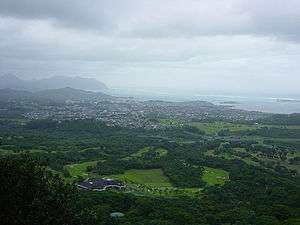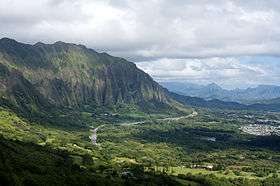Nu‘uanu Pali
| Nuʻuanu Pali | |
|---|---|
|
Looking towards the northern Koʻolau Range from the Nuʻuanu Pali overlook | |
| Elevation | 1,168 ft (356 m)[1] |
| Traversed by |
|
| Location |
|
| Coordinates | 21°22′01″N 157°47′36″W / 21.3668482°N 157.7933264°WCoordinates: 21°22′01″N 157°47′36″W / 21.3668482°N 157.7933264°W |
| Topo map | USGS Honolulu |
 The pass is located in Honolulu County | |
Nuʻuanu Pali is a section of the windward cliff (pali[2] in Hawaiian) of the Koʻolau mountain located at the head of Nuʻuanu Valley[3] on the island of Oʻahu. It has a panoramic view of the windward (northeast) coast of Oʻahu. The Pali Highway (Hawaii State Highway 61) connecting Kailua/Kāneʻohe with downtown Honolulu runs through the Nuʻuanu Pali Tunnels bored into the cliffside.
The area is also the location of the Nuʻuanu Freshwater Fish Refuge[4] and the Nuʻuanu Reservoir[5][6] in the jurisdiction of the Hawaiʻi Department of Land and Natural Resources.
The Nuʻuanu Pali State Wayside is a lookout above the tunnels where there is a panoramic view of the Oʻahu's windward side with views of Kāneʻohe, Kāneʻohe Bay, and Kailua. It is also well known for strong trade winds that blow through the pass (now bypassed by the Nuʻuanu Pali Tunnels).
History

The Nuʻuanu Pali has been a vital pass from ancient times to the present because it is a low, traversable section of the Koʻolau mountain range that connects the leeward side of the mountains, Honolulu to the windward side, Kailua and Kāneʻohe. The route drew settlers who formed villages in the area and populated Nuʻuanu Valley for a thousand years.
The Nuʻuanu Pali was the site of the Battle of Nuʻuanu, one of the bloodiest battles in Hawaiian history, in which Kamehameha I conquered the island of Oʻahu, bringing it under his rule. In 1795 Kamehameha I sailed from his home island of Hawaiʻi with an army of 10,000 warriors, including a handful of non-Hawaiian foreigners. After conquering the islands of Maui and Molokaʻi, he moved on to Oʻahu. The pivotal battle for the island occurred in Nuʻuanu Valley, where the defenders of Oʻahu, led by Kalanikūpule, were driven back up into the valley where they were trapped above the cliff. More than 400 of Kalanikūpule's soldiers were driven off the edge of the 1,000-foot cliff to their deaths.
In 1845 the first road was built over the Nuʻuanu Pali, to connect Windward Oʻahu with Honolulu. In 1898, as this road was developed into a highway, workers found 800 human skulls—believed to be the remains of the warriors who fell to their deaths from the cliff above.[7] This road was later replaced by the Pali Highway and the Nuʻuanu Pali Tunnels in 1959, which is the route used today.
The now extinct bird, the Oʻahu nukupuʻu, was last collected in this valley.
Nuʻuanu Reservoir
The Nuʻuanu Reservoir is located up the Nuʻuanu Pali heading towards Kailua, in the valley jungle. This small body of water holds various species of catfish, and peacock bass. In efforts towards preserving the Reservoir, appointments must be made half a year prior to the visiting date. This ensures a controlled amount of residents that fish out of the waters, preventing overfishing. A fresh water game fishing license and an entry fishing card are required to fish there. There is a two fish per license limit, and any catfish that is 16 inches or larger must be kept.
Nuʻuanu Trail
The trail to Nuuʻuanu began at Kalanikahua and led north of Kaumakapili Church to below the stream which flowed out of Kamanuwai pond. There the trail turned slightly to the right, went along the edge of the pond, and down into the water. Then, coming up on the bank onto Waiakemi, it led on to Waakekupua, along the bank of the taro patches, to the Pauoa stream, up to Pualoalo, and on to the gap at Nuʻuanu Pali.[8]
Superstition

Two large stones near the back of Nuʻuanu Valley, Hapuʻu and Ka-lae-hau-ola, were said to represent a pair of goddesses who were guardians of the passage down the pali. Travellers would leave offerings of flowers or kapa (bark cloth) to ensure a safe trip, and parents buried the umbilical cords of newborns under the stones as a protection against evil.[9]
It is said there is a moʻo wahine (lizard woman) who lingers around the pass. A moʻo wahine is mythical creature who takes the form of a beautiful woman and leads male travelers to their deaths off the cliff. She is similar to a western poltergeist or mermaid.
Hawaiian folklore holds that people should never carry pork over Nuʻuanu Pali, especially at night. Pele (a more powerful and influential goddess than the moʻo wahine) was said to be responsible for this to prevent the passage of pork over the Pali. It was said Pele, the volcano goddess, was responsible for preventing passage due to her contest with Kamapua'a, a half human, half hog god, and would not allow him (in the form of pork) to trespass on her side of the island.
Cultural references
"Pali Gap" is the title of a track from the posthumous 1971 album Rainbow Bridge by the guitarist Jimi Hendrix.
'The Pali', together with surrounding areas such as Tantalus Crater, is the main setting in the novel Micro by Michael Crichton and Richard Preston.
Places of interest
Photos

See also
References
- ↑ "Nuuanu Pali". Geographic Names Information System. United States Geological Survey. Retrieved July 19, 2014.
- ↑ Pukui, Mary Kawena; Elbert, Samuel H.; Mookini, Esther T. (1974). Place Names of Hawaii (2 ed.). Honolulu, HI: The University Press of Hawaii. p. 177. ISBN 0-8248-0208-X.
- ↑ "Nuʻuanu, Oʻahu Home Page". Pacific Worlds & Associates. 2003.
Nuʻuanu, the principle valley of Honolulu ahupuaʻa on the Island of Oʻahu, in the Hawaiian chain. Nuʻuanu reaches from Honolulu Harbor to the famous Nuʻuanu Pali.
- ↑ "Nuʻuanu Freshwater Fish Refuge (Nuʻuanu Reservoir No. 4), Oʻahu". Hawaiʻi Department of Land and Natural Resources, Division of Aquatic Resources, Hawaii.gov. 2007.
- ↑ Kawehi Haug (11 May 2005). "Nuʻuanu Reservoir". Honolulu Weekly.
Despite its industrial name, the Nuʻuanu Reservoir is all nature. Hidden behind the tall trees on the town side of the Pali tunnels (and perhaps outshined by the nearby Pali Lookout), the reservoir is an unexpected haven of too-good-to-be-true beauty. The Department of Land and Natural Resources controls the area but it issues permits to the public to picnic and fish… There is a movement underway by the Friends of Nuʻuanu Reservoir to turn the place into a public park…
- ↑ Dennis Hollier (October–November 2007). "Reservoir Cats". Hana Hou! Vol. 10 No. 5.
The clams are just one of the surprises here, high in Nuʻuanu Valley on Oʻahu. The lake, which once supplied drinking water to Honolulu, is also home to cichlids and tilapia. Even more surprising—in a land better known for saltwater fishing—these fresh waters yield channel catfish reaching over 20 pounds.
- ↑ Jeanette Foster; Pauline Frommer; David Thompson (2008). Pauline Frommer's Hawaii: Spend Less, See More (2 ed.). Frommer's. p. 153. ISBN 0-470-18411-6.
- ↑ Sterling, Elspeth; Summers, Catherine (1978). Sites of Oahu. Honolulu: Bishop Museum. pp. 294–295. ISBN 0-910240-73-6.
- ↑ "Footprints: Guardian Stones of Nuʻuanu Valley".
External links
- Nu'uanu Pali State Wayside - official site
